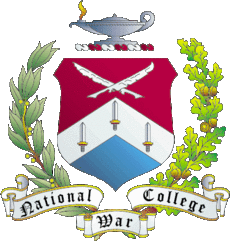National War College
|
Shield of the National War College | |
| Type | Federal staff college |
|---|---|
| Established | July 1, 1946 |
Parent institution | National Defense University |
| Location |
Fort Lesley J. McNair Washington, D.C., USA |
| Commandant | BG Guy Consentino, USA[1] |
|
National War College | |
|
| |
 | |
| Location | Washington, D.C. |
| Built | 1903–07 |
| Architect | McKim, Mead, and White |
| Architectural style |
Neo-Classical; Beaux Arts |
| NRHP Reference # | 72001535[2] |
| Added to NRHP | November 28, 1972 |
The National War College (NWC) of the United States is a school in the National Defense University. It is housed in Roosevelt Hall on Fort Lesley J. McNair, Washington, D.C., the third-oldest Army post still active.
History
The National War College ("NWC") was officially established on July 1, 1946, as an upgraded replacement for the Army-Navy Staff College, which operated from June 1943 to July 1946. The college was one of James Forrestal's favorite causes.[3]
According to Lt. Gen. Leonard T. Gerow, President of the Board which recommended its formation,
The College is concerned with grand strategy and the utilization of the national resources necessary to implement that strategy. ... Its graduates will exercise a great influence on the formulation of national and foreign policy in both peace and war....
Mid-level and senior military officers who are likely to be promoted to the most senior ranks are selected to study at the War College in preparation for higher staff and command positions. About 75 percent of the student body is composed of equal representation from the land, air, and sea (including Marine and Coast Guard) services. The remaining 25 percent are drawn from the Department of State and other federal departments and agencies. In addition, international fellows from a number of countries join the student body. The curriculum is based upon critical analysis of strategic problem solving with emphasis on strategic leadership. Starting with the 2014–2015 academic year, the curriculum will be based upon a core standard throughout National Defense University.[4]
Because of NWC's privileged location close to the White House, the Supreme Court, and Capitol Hill, it has been able throughout its history to call upon an extraordinarily well-connected array of speakers to animate its discussions. All lectures at the National War College are conducted under a strict "no quotation nor attribution" policy which has facilitated discussion on some of the most difficult issues of the day.
Alumni and influence
Graduates of the National War College include numerous current and former flag officers, general officers, and U.S. ambassadors. Notable graduates include former U.S. Secretary of State and Chairman of the Joint Chiefs of Staff Colin Powell; U.S. Senator John McCain; former NATO Supreme Allied Commander Europe Wesley Clark; former Chairmen of the Joint Chiefs of Staff Peter Pace and Hugh Shelton; former National Security Advisor and NATO Supreme Allied Commander Europe James L. Jones; former U.S Army Chief of Staff Eric Shinseki; former U.S. Chief of Naval Operations Elmo Zumwalt; Commandant of the Marine Corps Robert H. Barrow; former U.S.A.F Chief of Staff Merrill A. McPeak; retired Air Force General Arnold W. Braswell; U.S. Ambassador to Russia John Beyrle; World War II submarine officer and best-selling novelist Edward L. Beach Jr.; former military aide to President John F. Kennedy, Godfrey McHugh; the late U.S. Ambassador to Libya J. Christopher Stevens; the late Brigadier General John Ray Budner formerly in command of the North American Air Defense Command Combat Operations Center; and former U.S. Air Force Chief of Staff Norton A. Schwartz; one of the initial nuclear theorists Bernard Brodie was a founding faculty member.
Roosevelt Hall
Roosevelt Hall (built 1903–1907) is a Beaux Arts–style building housing the NWC since its inception in 1946. Designed by the New York architectural firm McKim, Mead and White, it is now designated a National Historical Landmark and is listed on the National Register of Historic Places.
.jpg) Roosevelt Hall of National War College
Roosevelt Hall of National War College
See also
- Air War College
- Industrial College of the Armed Forces
- List of National Historic Landmarks in the District of Columbia
- Marine Corps War College
- National Register of Historic Places listings in the District of Columbia
- Naval War College
- United States Army War College
References
- ↑ "Welcoming the new Commandant: BG Guy "Tom" Cosentino". National War College Alumni Association. June 10, 2013.
- ↑ National Park Service (2007-01-23). "National Register Information System". National Register of Historic Places. National Park Service.
- ↑ Garry Wills, Bomb Power (Penguin, 2010), p. 68
- ↑ Gregg Martin and John Yaeger, "Break Out: A Plan for Better Equipping the Nations Future Strategic Leaders", Joint Force Quarterly (April 2014), pp. 39–43.
External links
| Wikimedia Commons has media related to National War College. |
Coordinates: 38°51′48″N 77°01′01″W / 38.86333°N 77.01694°W

